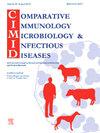The impact of stray animal populations on public health in Naples, Italy: A preliminary study on antimicrobial resistance on the road
IF 2
3区 农林科学
Q4 IMMUNOLOGY
Comparative Immunology Microbiology and Infectious Diseases
Pub Date : 2025-04-26
DOI:10.1016/j.cimid.2025.102344
引用次数: 0
Abstract
The rise of antimicrobial resistance poses a significant public health challenge, with an increasing number of organisms developing resistance to many antimicrobial agents used to treat infections in humans and animals. This study investigated the role of stray dogs and cats as sentinel animals in the urban environment. Therefore, the sampling of healthy skin was performed to isolate bacterial species present and assess their antimicrobial resistance profile. A total of 690 swabs were collected, comprising 351 cutaneous swabs from dogs and 339 from cats. A total of 770 strains were identified, including 381 Gram-positive bacteria (94 %) and 19 Gram-negative bacteria (6 %) from dogs, and 355 Gram-positive bacteria (97 %) and 11 Gram-negative bacteria (3 %) from cats. In dogs, Staphylococcus pseudintermedius was the most frequently isolated Gram-positive bacterium, with 53 strains identified. Meanwhile, in cats, coagulase-negative staphylococci were the most common, with Staphylococcus felis being the predominant species, represented by 50 strains. Among the isolated Gram-negative bacteria in both animal species, E. coli was predominant. Among the recovered Gram-positive bacteria, multidrug resistance was observed in 105 out of 129 (81.4 %) canine isolates and 87 out of 143 (60.8 %) feline isolates. Additionally, phenotypic resistance to penicillin, oxacillin, and cefoxitin in 42 out of 53 (79.2 %) S. pseudintermedius strains and 8 out of 50 (16.0 %) S. felis strains was identified, suggesting the presence of the methicillin resistance gene. The above findings underscore the need for stricter monitoring of antibiotic resistance specifically in stray dogs and cats which can act as reservoirs for resistant bacteria.
意大利那不勒斯流浪动物种群对公共卫生的影响:道路上抗微生物药物耐药性的初步研究
抗菌素耐药性的上升对公共卫生构成重大挑战,越来越多的生物体对用于治疗人类和动物感染的许多抗菌素产生耐药性。本研究调查了流浪狗和流浪猫在城市环境中作为哨兵动物的作用。因此,对健康皮肤进行取样,以分离存在的细菌种类并评估其抗菌素耐药性。共收集了690份拭子,其中351份来自狗,339份来自猫。共检出菌株770株,其中犬革兰氏阳性菌381株(94 %)、革兰氏阴性菌19株(6 %);猫革兰氏阳性菌355株(97 %)、革兰氏阴性菌11株(3 %)。在狗中,假中间葡萄球菌是最常见的分离革兰氏阳性细菌,鉴定出53株。同时,在猫中以凝固酶阴性葡萄球菌最常见,以猫葡萄球菌为优势种,有50株。两种动物分离的革兰氏阴性菌均以大肠杆菌为主。检出的革兰氏阳性菌129株犬分离株中有105株(81.4 %)耐多药,143株猫分离株中有87株(60.8 %)耐多药。此外,53株假中间链球菌中有42株(79.2% %)和50株猫链球菌中有8株(16.0% %)对青霉素、oxacillin和头孢西丁具有表型抗性,表明存在甲氧西林耐药基因。上述发现强调需要对抗生素耐药性进行更严格的监测,特别是对可能成为耐药细菌宿主的流浪狗和猫。
本文章由计算机程序翻译,如有差异,请以英文原文为准。
求助全文
约1分钟内获得全文
求助全文
来源期刊
CiteScore
4.60
自引率
0.00%
发文量
102
审稿时长
40 days
期刊介绍:
Comparative Immunology, Microbiology & Infectious Diseases aims to respond to the concept of "One Medicine" and to provide a venue for scientific exchange. Based on the concept of "Comparative Medicine" interdisciplinary cooperation between specialists in human and animal medicine is of mutual interest and benefit. Therefore, there is need to combine the respective interest of physicians, veterinarians and other health professionals for comparative studies relevant to either human or animal medicine .
The journal is open to subjects of common interest related to the immunology, immunopathology, microbiology, parasitology and epidemiology of human and animal infectious diseases, especially zoonotic infections, and animal models of human infectious diseases. The role of environmental factors in disease emergence is emphasized. CIMID is mainly focusing on applied veterinary and human medicine rather than on fundamental experimental research.

 求助内容:
求助内容: 应助结果提醒方式:
应助结果提醒方式:


